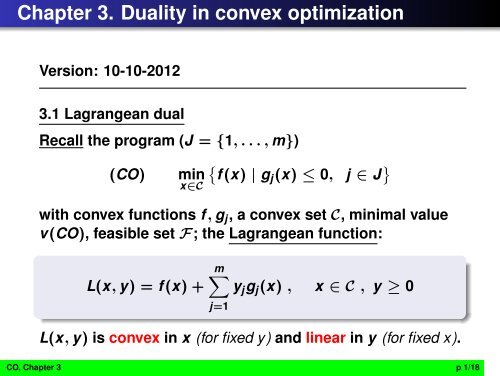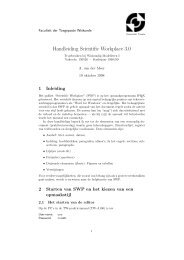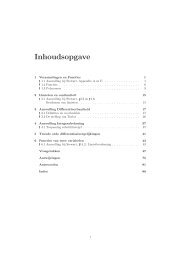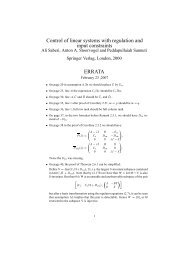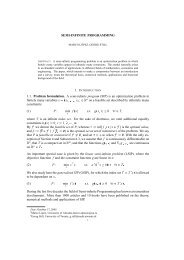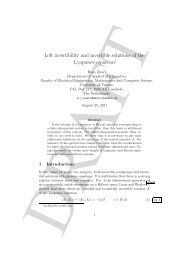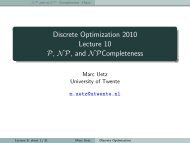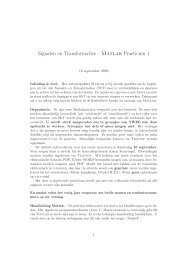Chapter 3. Duality in convex optimization
Chapter 3. Duality in convex optimization
Chapter 3. Duality in convex optimization
You also want an ePaper? Increase the reach of your titles
YUMPU automatically turns print PDFs into web optimized ePapers that Google loves.
<strong>Chapter</strong> <strong>3.</strong> <strong>Duality</strong> <strong>in</strong> <strong>convex</strong> <strong>optimization</strong><br />
Version: 10-10-2012<br />
<strong>3.</strong>1 Lagrangean dual<br />
Recall the program (J = {1, . . . , m})<br />
{<br />
(CO) m<strong>in</strong> f (x) | gj (x) ≤ 0, j ∈ J }<br />
x∈C<br />
with <strong>convex</strong> functions f , g j , a <strong>convex</strong> set C, m<strong>in</strong>imal value<br />
v(CO), feasible set F; the Lagrangean function:<br />
m∑<br />
L(x, y) = f (x) + y j g j (x) , x ∈ C , y ≥ 0<br />
j=1<br />
L(x, y) is <strong>convex</strong> <strong>in</strong> x (for fixed y) and l<strong>in</strong>ear <strong>in</strong> y (for fixed x).<br />
CO, <strong>Chapter</strong> 3 p 1/18
Def<strong>in</strong><strong>in</strong>g<br />
ψ(y) := <strong>in</strong>f {f (x) + ∑<br />
m y j g j (x)}<br />
x∈C<br />
the Lagrangean-dual problem of (CO) can be written as:<br />
(D) :<br />
sup<br />
y≥0<br />
ψ(y)<br />
j=1<br />
The (sup-)value of (D) is denoted by v(D).<br />
L.<strong>3.</strong>2 (Even without <strong>convex</strong>ity assumptions on (CO))<br />
The function ψ(y) is a concave function and thus, (D), the<br />
Lagrangean dual of (CO) is a <strong>convex</strong> program.<br />
Note: By def<strong>in</strong>ition ψ(y) is called concave if −ψ(y) is <strong>convex</strong>.<br />
So that max y ψ ≡ m<strong>in</strong> y −ψ (a <strong>convex</strong> problem).<br />
Note:!! The follow<strong>in</strong>g weak and strong duality results are<br />
more general than the results of Th.<strong>3.</strong>4, Th.<strong>3.</strong>6 <strong>in</strong> KRT.<br />
CO, <strong>Chapter</strong> 3 p 2/18
Th.<strong>3.</strong>4’ [weak duality] (without <strong>convex</strong>ity assumptions on (CO))<br />
{<br />
sup ψ(y) ≤ <strong>in</strong>f f (x) | gj (x) ≤ 0 , j ∈ J }<br />
.<br />
y≥0<br />
x∈C<br />
} {{ } } {{ }<br />
v(D)<br />
v(CO)<br />
In particular:<br />
if equality holds for y ≥ 0:<br />
{<br />
ψ(y) = <strong>in</strong>f f (x) | gj (x) ≤ 0 , j ∈ J }<br />
x∈C<br />
then y is a solution of (D).<br />
If we have ψ(y) = f (x) for y ≥ 0, x ∈ F then y, x are<br />
optimal solutions of (D), (CO), respectively.<br />
Def. The value v(CO) − v(D) ≥ 0 is called duality gap.<br />
(This gap may be positive).<br />
We show <strong>in</strong> the next theorem that there is no duality gap if<br />
(CO) satisfies the Slater condition<br />
CO, <strong>Chapter</strong> 3 p 3/18
Th.2 [strong duality] Suppose (CO) satisfies the Slater<br />
condition ( so v(CO) < ∞). Then<br />
sup<br />
y≥0<br />
{<br />
ψ(y) = <strong>in</strong>f f (x) | gj (x) ≤ 0 , j ∈ J }<br />
x∈C<br />
If moreover v(CO) is bounded from below (i.e., it is<br />
bounded), then the dual optimal value is atta<strong>in</strong>ed.<br />
Proof. (For the case −∞ < v(CO) < ∞) Let a = v(CO) be the<br />
optimal value of (CO). From the Farkas Lemma 2.25 it follows<br />
that there exists a vector y = (y 1 ; . . . ; y m ) ≥ 0 such that<br />
m∑<br />
L(x, y) = f (x) + y j g j (x) ≥ a , ∀x ∈ C, or<br />
j=1<br />
<strong>in</strong>f L(x, y) ≥ a.<br />
x∈C<br />
By the def<strong>in</strong>ition of ψ(y) this implies ψ(y) ≥ a. Us<strong>in</strong>g the weak<br />
duality theorem, it follows a ≤ ψ(y) ≤ v(D) ≤ v(CO) = a and<br />
thus a = ψ(y) = v(CO). So, y is a maximizer of (D). ⋄<br />
CO, <strong>Chapter</strong> 3 p 4/18
Note that the existence of a m<strong>in</strong>imizer of (the primal) (CO)<br />
is not asured <strong>in</strong> Th. 2.<br />
Example 1. (Slater holds so zero duality gap; solutions of (D)<br />
and (CO) exist.)<br />
Consider<br />
{<br />
(CO) m<strong>in</strong> f := x1 2 + x 2 2 | x 1 + x 2 ≥ 1 , (x 1 , x 2 ) ∈ R 2} .<br />
Here: L(x, y) = x 2 1 + x 2 2 + y (1 − x 1 − x 2 ) . S<strong>in</strong>ce L(x, y) is<br />
<strong>convex</strong> <strong>in</strong> x, (for fixed y) L(x, y) is m<strong>in</strong>imal if and only if<br />
∇ x L(x, y) = 0, e.g. if 2x 1 − y = 0 and 2x 2 − y = 0. This yields<br />
x 1 = y 2 , x 2 = y 2 .<br />
Substitution gives ψ(y) = y 2<br />
y 2<br />
2<br />
+ y (1 − y) = y<br />
}<br />
−<br />
2 .<br />
So the dual problem is: max<br />
{y − y 2<br />
2 | y ≥ 0<br />
with maximizer y = 1. So x 1 = x 2 = 1 2<br />
is the m<strong>in</strong>imizer of (CO)<br />
and v(CO) = v(D) = 1/2.<br />
CO, <strong>Chapter</strong> 3 p 5/18
Example 2. (No Slater but without duality gap)<br />
(CO) m<strong>in</strong> x s.t. x 2 ≤ 0, x ∈ R<br />
This (CO) problem is not Slater regular and has solution x = 0<br />
with v(CO) = 0. On the other hand, we have<br />
{<br />
ψ(y) = <strong>in</strong>f (x + yx 2 − 1 for y > 0<br />
) = 4y<br />
x∈R −∞ for y = 0.<br />
We see that ψ(y) < 0 for all y ≥ 0. One has<br />
sup {ψ(y) | y ≥ 0} = 0.<br />
So the Lagrange-dual (D) has the same optimal value as the<br />
primal problem. In spite of the lack of Slater regularity there is<br />
no duality gap; however a solution of (D) doesn’t exist.<br />
CO, <strong>Chapter</strong> 3 p 6/18
<strong>3.</strong>2 The Wolfe-dual<br />
We reconsider (CO) with C = R n , f , g j ∈ C 1 , <strong>convex</strong> and<br />
its Lagrangean dual:<br />
(D)<br />
sup<br />
y≥0<br />
{ψ(y) := <strong>in</strong>f L(x, y)}<br />
x∈Rn where L(x, y) = f (x) + ∑ m<br />
j=1 y jg j (x).<br />
Recall: x is a m<strong>in</strong>imizer of ψ(y) iff ∇ x L(x, y) = 0.<br />
In that case: <strong>in</strong>f x∈C L(x, y) = L(x, y). So, (provided, a<br />
solution of ψ(y) exists) the Lagrangean dual takes the form:<br />
(WD)<br />
sup{f (x) +<br />
x,y<br />
m∑<br />
y j g j (x)} s.t. y ≥ 0 and<br />
j=1<br />
∇ x L(x, y) ≡ ∇f (x) +<br />
m∑<br />
y j ∇g j (x) = 0 .<br />
j=1<br />
CO, <strong>Chapter</strong> 3 p 7/18
Def.<strong>3.</strong>8 (WD) is called the Wolfe-Dual of (CO). (In general,<br />
(WD) is not a <strong>convex</strong> problem.)<br />
Th.<strong>3.</strong>9 (weak duality) If ˆx is feasible for (CO) and (x, y) is a<br />
feasible po<strong>in</strong>t of (WD) then<br />
L(x, y) ≤ f (ˆx).<br />
If L(x, y) = f (ˆx) holds then (x, y) is a solution of (WD) and<br />
ˆx is a m<strong>in</strong>imizer of (CO)<br />
From Corollary 2.33 (or Theorem 2.30) we obta<strong>in</strong>:<br />
Th.<strong>3.</strong>10 (partial strong duality) Let (CO) satisfy the Slater<br />
condition. If the feasible po<strong>in</strong>t x ∈ F is a m<strong>in</strong>imizer of<br />
(CO) then there exists y ≥ 0 such that (x, y) is an optimal<br />
solution of (WD) and L(x, y) = f (x).<br />
CO, <strong>Chapter</strong> 3 p 8/18
Rem. Only under additional assumptions (e.g., second order<br />
conditions) also the converse of Th.<strong>3.</strong>10 holds.<br />
Rem. Together with the results <strong>in</strong> Ch. 2, the Th.<strong>3.</strong>10 also<br />
says: If (x, y) is a KKT po<strong>in</strong>t (or equivalently a saddlepo<strong>in</strong>t of<br />
L(x, y)) then (x, y) is a maximizer of (WD).<br />
Example <strong>3.</strong>11. (Application of the Weak <strong>Duality</strong> for (WD))<br />
Consider the <strong>convex</strong> <strong>optimization</strong> problem<br />
(CO)<br />
m<strong>in</strong> x 1 + e x 2<br />
s.t. 3x 1 − 2e x 2<br />
≥ 10, x 2 ≥ 0.<br />
x∈R 2<br />
Note that x = (4, 0) is feasible with objective value f (x) = 5.<br />
To show that this is the m<strong>in</strong>imizer, by Th. <strong>3.</strong>9, it suffice to show<br />
that the value of the Wolfe-dual of (CO) is also 5:<br />
(WD) sup L = x 1 + e x 2<br />
+ y 1 (10 − 3x 1 + 2e x 2) − y 2 x 2<br />
x,y<br />
s.t. 1 − 3y 1 = 0<br />
e x 2<br />
+ 2e x 2y 1 − y 2 = 0, x ∈ R 2 , y ≥ 0.<br />
which is a non-<strong>convex</strong> problem. The first constra<strong>in</strong>t gives<br />
CO, <strong>Chapter</strong> 3 p 9/18
y 1 = 1 3<br />
, and thus the second constra<strong>in</strong>t becomes<br />
5<br />
3 ex 2<br />
− y 2 = 0.<br />
Now we can elim<strong>in</strong>ate y 1 and y 2 from L(x, y) to obta<strong>in</strong> The<br />
Lagrangean reduces to<br />
L = 5 3 ex 2<br />
− 5 3 x 2e x 2<br />
+ 10<br />
3 .<br />
This function has a maximum when<br />
L ′ (x 2 ) = − 5 3 x 2e x 2<br />
= 0,<br />
which implies x 2 = 0 and L = 5. Hence the optimal value of<br />
(WD) is 5 with solution (x, y) = (4, 0, 1 3 , 5 3<br />
). Weak duality<br />
implies that x = (4, 0) is m<strong>in</strong>imizer of (CO).<br />
Remark: A substitution z = e x 2<br />
≥ 1 would lead to a l<strong>in</strong>ear<br />
problem.<br />
CO, <strong>Chapter</strong> 3 p 10/18
General remarks on duality:<br />
The Wolfe-duality concept and duality via saddle<br />
po<strong>in</strong>ts is restricted to the case where a solution x of<br />
the primal program (CO) exists.<br />
The Lagrange duality approach is more general. The<br />
existence of a m<strong>in</strong>imizer of (CO) is not required.<br />
Wolfe’s dual is useful to f<strong>in</strong>d a suitable form of the dual<br />
of a <strong>convex</strong> program.<br />
[KRT,Sec.<strong>3.</strong>4] gives some examples with positive duality<br />
gap. The follow<strong>in</strong>g example <strong>in</strong> particular shows that Wolfe- and<br />
Lagrangean-duality are not (always) the same √<br />
Ex. <strong>3.</strong>12. (CO) m<strong>in</strong> x∈R 2 e −x 2<br />
s.t. x1 2 + x 2 2 ≤ x 1<br />
Here the feasible set is F = {(x 1 , x 2 ) | x 2 = 0, x 1 ≥ 0} (all<br />
feasible po<strong>in</strong>ts are m<strong>in</strong>imizers) and<br />
v(WD) = −∞ < v(D) = 0 < v(CO) = 1.<br />
CO, <strong>Chapter</strong> 3 p 11/18
<strong>3.</strong>3 Examples of dual problems<br />
The Wolfe dual can be used to f<strong>in</strong>d the Lagrangean dual.<br />
<strong>Duality</strong> for L<strong>in</strong>ear Optimization (LP)<br />
Let A ∈ R m×n , b ∈ R m and c, x ∈ R n .<br />
(P)<br />
max<br />
y<br />
The correspond<strong>in</strong>g (Wolfe-) dual is<br />
{<br />
b T y | A T y ≤ c<br />
Consider the LP:<br />
}<br />
.<br />
(D)<br />
m<strong>in</strong><br />
x<br />
{c T x | Ax = b , x ≥ 0}.<br />
Ex.<br />
Show that (D) is also the Lagrangean dual of (P).<br />
Rem. S<strong>in</strong>ce the Slater condition is (automatically) fulfilled,<br />
strong (Lagrangean) duality holds if (P) is feasible.<br />
CO, <strong>Chapter</strong> 3 p 12/18
Convex quadratic programm<strong>in</strong>g duality<br />
Consider with positive semidef<strong>in</strong>ite Q ∈ R n×n the<br />
quadratic program<br />
{<br />
}<br />
(P) m<strong>in</strong> c T x + 1<br />
x 2 x T Qx | Ax ≥ b, x ≥ 0<br />
,<br />
with l<strong>in</strong>ear constra<strong>in</strong>ts and <strong>convex</strong> object function. The<br />
Wolfe-dual is:<br />
{<br />
}<br />
(D) b T y − 1 2 x T Qx | A T y − Qx ≤ c .<br />
max<br />
y≥0,x<br />
Proof: Writ<strong>in</strong>g (P) as<br />
{<br />
}<br />
m<strong>in</strong> c T x + 1<br />
x∈R n 2 x T Qx | b − Ax ≤ 0 , −x ≤ 0<br />
the Wolfe-dual becomes: max y≥0,s≥0,x {c T x + 1 2 x T Qx+<br />
y T (b − Ax) − s T x | c + Qx − A T y − s = 0}.<br />
CO, <strong>Chapter</strong> 3 p 13/18
Substitut<strong>in</strong>g c = −Qx + A T y + s <strong>in</strong> the objective, we get<br />
c T x + 1 2 x T Qx + y T (b − Ax) − s T x<br />
= ( −Qx + A T y + s ) T<br />
x +<br />
1<br />
2 x T Qx + y T (b − Ax) − s T x<br />
=<br />
=<br />
(−Qx) T x + 1 2 x T Qx + y T b<br />
b T y − 1 2 x T Qx.<br />
Hence the problem simplifies to<br />
max<br />
y≥0,s≥0,x<br />
By elim<strong>in</strong>at<strong>in</strong>g s this becomes<br />
max<br />
y≥0,x<br />
{<br />
b T y − 1 2 x T Qx | c + Qx − A T y − s = 0<br />
{<br />
b T y − 1 2 x T Qx | A T y − Qx ≤ c<br />
}<br />
.<br />
}<br />
.<br />
CO, <strong>Chapter</strong> 3 p 14/18
<strong>3.</strong>5 Semidef<strong>in</strong>ite <strong>optimization</strong><br />
Semidef<strong>in</strong>ite programs (SDP) provide an important<br />
generalization of L<strong>in</strong>ear programs.<br />
Def. Let S m denote the set of all symmetric matrices.<br />
For A, B ∈ S m we def<strong>in</strong>e the <strong>in</strong>ner product A • B by<br />
A • B = ∑ i,j<br />
a ij b ij (= trace A · B)<br />
S m +<br />
denotes the set of all psd. matrices A (A ≽ 0).<br />
CO, <strong>Chapter</strong> 3 p 15/18
Semidef<strong>in</strong>ite program: Let A 0 , A 1 , . . . , A n ∈ S m , c ∈ R n<br />
and let x ∈ R n be the vector of unknowns.<br />
The primal SDP is:<br />
{<br />
(P) m<strong>in</strong> c T x | F (x) := −A 0 + ∑ n<br />
}<br />
A k x k ≽ 0<br />
x k=1<br />
The dual problem is (as we shall see):<br />
(D) max<br />
Z {A 0 • Z | A k • Z = c k , k = 1, .., n , Z ≽ 0}<br />
Ex. Show: Both programs, (P) and (D) are <strong>convex</strong><br />
problems.<br />
Rem. If the matrices A 0 , A 1 , . . . , A n are diagonal matrices then<br />
(P) is simply a l<strong>in</strong>ear program with (l<strong>in</strong>ear) dual (D).<br />
CO, <strong>Chapter</strong> 3 p 16/18
Weak duality:<br />
We need the follow<strong>in</strong>g facts:<br />
Exercise. (Let A ∈ S m , x ∈ R m ) Then<br />
1 x T Ax = A • xx T<br />
2 There is an orthonormal basis of eigenvectors x i ∈ R m<br />
of A and correspond<strong>in</strong>g eigenvalues λ i , i = 1, .., m<br />
such that:<br />
∑<br />
A = m λ i x i xi T .<br />
i=1<br />
If <strong>in</strong> addition A ≽ 0 holds then A = BB T , where B is<br />
the matrix with columns √ λ i x i .<br />
3 S, Z ∈ S m +<br />
⇒ S • Z ≥ 0 (and “=” holds iff S · Z = 0).<br />
4<br />
{<br />
<strong>in</strong>f S • Z = 0 if Z ≽ 0,<br />
S∈S m −∞ otherwise.<br />
+<br />
CO, <strong>Chapter</strong> 3 p 17/18
Th.<strong>3.</strong>17 (week duality) If x ∈ R n is primal feasible and<br />
Z ∈ R m×m is dual feasible, then<br />
c T x − A 0 • Z = F (x) • Z ≥ 0.<br />
Equality holds iff F (x) · Z = 0 (and <strong>in</strong> this case x, Z are<br />
optimal for (P), (D), respectively).<br />
Remark. [Without proof (see, e.g., [FKS, Ch.12])]<br />
Strong duality holds under the assumption that (P) is solvable<br />
and that there exists a strictly feasible x ∗ :<br />
F (x ∗ ) ≻ 0<br />
CO, <strong>Chapter</strong> 3 p 18/18


